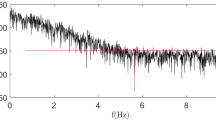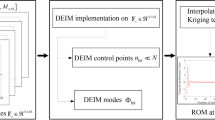Abstract
In this study, identification of nonlinear aerodynamic systems based on an improved nonlinear state-space modeling approach is presented to predict transonic aeroelastic behaviors of aircraft structures. It starts with identifying a linear state-space aerodynamic model by using the eigensystem realization algorithm and observer/Kalman filter identification methods. Subsequently, the remaining parameters of the nonlinear state-space aerodynamic model are determined through an output error-minimization procedure, based on a new training data generation methodology. To illustrate the approach, two- and three-dimensional transonic aeroelastic configurations are studied. The transonic aeroelastic behaviors predicted via the proposed approach agree well with those obtained via computational fluid dynamics technique in the interested range of dynamic pressure.




































Similar content being viewed by others
References
Livne, E.: Aircraft active flutter suppression: state of the art and technology maturation needs. J. Aircr. 55(1), 410–452 (2017)
Huang, R., Qian, W., Hu, H., Zhao, Y.: Design of active flutter suppression and wind-tunnel tests of a wing model involving a control delay. J. Fluids Struct. 55, 409–427 (2015)
Huang, R., Zhao, Y., Hu, H.: Wind-tunnel tests for active flutter control and closed-loop flutter identification. AIAA J. 54(7), 2089–2099 (2016)
Chen, G., Zhou, Q., Ronch, A.D., Li, Y.: Computational-fluid-dynamics-based aeroservoelastic analysis for gust load alleviation. J. Aircr. 55(4), 1619–1628 (2018)
Hall, K.C., Thomas, J.P., Dowell, E.H.: Proper orthogonal decomposition technique for transonic unsteady aerodynamic flows. AIAA J. 38(10), 1853–1862 (2000)
Amsallem, D., Farhat, C.: Interpolation method for adapting reduced-order models and application to aeroelasticity. AIAA J. 46(7), 1803–1813 (2008)
Chen, G., Li, Y., Yan, G.: A nonlinear POD reduced order model for limit cycle oscillation prediction. Sci. China Phys. Mech. Astron. 53(7), 1325–1332 (2010)
Cowan, T.J., Arena, A.S., Gupta, K.K.: Accelerating computational fluid dynamics based aeroelastic predictions using system identification. J. Aircr. 38(1), 81–87 (2001)
Raveh, D.E.: Identification of computational-fluid-dynamics based unsteady aerodynamic models for aeroelastic analysis. J. Aircr. 41(3), 620–632 (2004)
Silva, W.A.: Identification of nonlinear aeroelastic systems based on the Volterra theory: progress and opportunities. Nonlinear Dyn. 39(1–2), 25–62 (2005)
Kim, T., Hong, M., Bhatia, K.G., Sengupta, G.: Aeroelastic model reduction for affordable computational fluid dynamics-based flutter analysis. AIAA J. 43(12), 2487–2495 (2005)
Silva, W.A.: Simultaneous excitation of multiple-input/multiple-output CFD-based unsteady aerodynamic systems. J. Aircr. 45(4), 1267–1274 (2008)
Lucia, D.J., Beran, P.S., Silva, W.A.: Reduced-order modeling: new approaches for computational physics. Prog. Aerosp. Sci. 40(1–2), 51–117 (2004)
Liu, H., Hu, H., Zhao, Y., Huang, R.: Efficient reduced-order modeling of unsteady aerodynamics robust to flight parameter variations. J. Fluids Struct. 49, 728–741 (2014)
Huang, R., Li, H., Hu, H., Zhao, Y.: Open/closed-loop aeroservoelastic predictions via nonlinear, reduced-order aerodynamic models. AIAA J. 53(7), 1812–1824 (2015)
Liu, H., Huang, R., Zhao, Y., Hu, H.: Reduced-order modeling of unsteady aerodynamics for an elastic wing with control surfaces. J. Aerosp. Eng. 30(3), 04016083 (2017)
Thomas, J.P., Dowell, E.H., Hall, K.C.: Using automatic differentiation to create a nonlinear reduced-order-model aerodynamic solver. AIAA J. 48(1), 19–24 (2010)
Yang, Z., Huang, R., Zhao, Y., Hu, H.: Design of an active disturbance rejection control for transonic flutter suppression. J. Guid. Control Dyn. 40(11), 2905–2916 (2017)
de Paula, N.C.G., Marques, F.D.: Multi-variable Volterra kernels identification using time-delay neural networks: application to unsteady aerodynamic loading. Nonlinear Dyn. 97, 767–780 (2019)
Kou, J., Zhang, W., Yin, M.: Novel Wiener models with a time-delayed nonlinear block and their identification. Nonlinear Dyn. 85(4), 2389–2404 (2016)
Balajewicz, M., Dowell, E.H.: Reduced-order modeling of flutter and limit-cycle oscillations using the sparse Volterra series. J. Aircr. 49(6), 1803–1812 (2012)
Huang, R., Hu, H., Zhao, Y.: Nonlinear reduced-order modeling for multiple-input/multiple-output aerodynamic systems. AIAA J. 52(6), 1219–1231 (2014)
Yao, W., Liou, M.S.: Reduced-order modeling for flutter/LCO using recurrent artificial neural network. In: 12th AIAA Aviation Technology, Integration, and Operations Conference, Indianapolis, Indiana (2012)
Zhang, W., Wang, B., Ye, Z., Quan, J.: Efficient method for limit cycle flutter analysis based on nonlinear aerodynamic reduced-order models. AIAA J. 50(5), 1019–1028 (2012)
Mannarino, A., Mantegazza, P.: Nonlinear aeroelastic reduced order modeling by recurrent neural networks. J. Fluids Struct. 48, 103–121 (2014)
Li, K., Kou, J., Zhang, W.: Deep neural network for unsteady aerodynamic and aeroelastic modeling across multiple Mach numbers. Nonlinear Dyn. 96(3), 2157–2177 (2019)
Mannarino, A., Dowell, E.H.: Reduced-order models for computational-fluid-dynamics-based nonlinear aeroelastic problems. AIAA J. 53(9), 2671–2685 (2015)
Huang, R., Liu, H., Yang, Z., Zhao, Y., Hu, H.: Nonlinear reduced-order models for transonic aeroelastic and aeroservoelastic problems. AIAA J. 56(9), 3718–3731 (2018)
Quan, E., Xu, M., Xie, D., Li, G.: Efficient nonlinear reduced-order model for computational fluid dynamics-based aeroelastic analysis. AIAA J. 56(9), 3701–3717 (2018)
Carrese, R., Joseph, N., Marzocca, P., Levinski, O.: Aeroelastic response of the AGARD 445.6 wing with freeplay nonlinearity. In: 58th AIAA/ASCE/AHS/ASC Structures, Structural Dynamics, and Materials Conference, Grapevine, Texas (2017)
Decuyper, J., De Troyer, T., Runacres, M.C., Tiels, K., Schoukens, J.: Nonlinear state-space modelling of the kinematics of an oscillating circular cylinder in a fluid flow. Mech. Syst. Signal Process. 98, 209–230 (2018)
Silva, W.A.: AEROM: NASA’s unsteady aerodynamic and aeroelastic reduced-order modeling software. Aerospace 5(2), 41 (2018)
Haykin, S.: Neural Networks and Learning Machines, 3rd edn, pp. 14–136. Prentice-Hall, Upper Saddle River, NJ (2008)
Kutz, J.N., Brunton, S.L., Brunton, B.W., Proctor, J.L.: Dynamic mode decomposition: data-driven modeling of complex systems. Soc. Ind. Appl. Math. (2016). https://doi.org/10.1137/1.9781611974508.bm
Juang, J.N., Pappa, R.S.: An eigensystem realization algorithm for modal parameter identification and model reduction. J. Guid. Control Dyn. 8(5), 620–627 (1985)
Silva, W.A., Bartels, R.E.: Development of reduced-order models for aeroelastic analysis and flutter prediction using the CFL3Dv6. 0 code. J. Fluids Struct. 19(6), 729–745 (2004)
Phan, M., Horta, L.G., Juang, J.N., Longman, R.W.: Linear system identification via an asymptotically stable observer. J. Optim. Theory Appl. 79(1), 59–86 (1993)
Landon, R.H.: NACA 0012 oscillating and transient pitching, data Set 3 in: Compendium of unsteady aerodynamic measurements. AGARDR-702 (1982)
Beran, P.S., Khot, N.S., Eastep, F.E., Snyder, R.D., Zweber, J.V.: Numerical analysis of store-induced limit-cycle oscillation. J. Aircr. 41(6), 1315–1326 (2004)
Acknowledgements
This work was supported by the Fundamental Research Funds for the Central Universities (No. NS2019002).
Author information
Authors and Affiliations
Corresponding author
Ethics declarations
Conflict of interest
The authors declare that there is no conflict of interest in relation to this article.
Additional information
Publisher's Note
Springer Nature remains neutral with regard to jurisdictional claims in published maps and institutional affiliations.
Rights and permissions
About this article
Cite this article
Liu, H., Gao, X. Identification of nonlinear aerodynamic systems with application to transonic aeroelasticity of aircraft structures. Nonlinear Dyn 100, 1037–1056 (2020). https://doi.org/10.1007/s11071-020-05553-2
Received:
Accepted:
Published:
Issue Date:
DOI: https://doi.org/10.1007/s11071-020-05553-2




